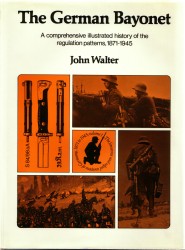Firearms Technical Trivia, December 1999:
 |
 |
 |
The firearms and accouterments that were used by the various German military organizations from before the time of its adoption of the bolt action metallic cartridge rifle (1871) to the end of the First World War (1918) bear unique historical signatures. These signatures, in the form of regimental markings stamped into the metal can give the collector and historian a good idea of whose hands grasped the rifle or bayonet in question, where it saw combat, and the history associated with the piece.
However, these signatures are of value only to the extent that one knows how to read them. Our intent here is to provide a rudimentary introduction to these markings and their significance. However, it cannot be stressed enough that the study of the formations that made up the Imperial German military forces is a tortuous and complex discipline in and of itself. And now, without further ado, let's examine the markings:
Upon
first glance at a piece, one is struck by a confusing jumble of numbers
and letters that may look something like this:
|
|
The Regimental Number
|
|
The Regimental Type
|
|
The two R.R. marks can be differentiated by the numbers following the letters. A single set of numbers indicates a recruiting depot, while two sets usually indicate a reserve infantry regiment. Just to keep things interesting, however, some reserve infantry regiments had more than one recruiting depot, and thus might have a depot number preceding the last number, thus looking very much like the markings for a reserve infantry regiment.
The Company Number
|
|
The Weapon Number
|
|
Read completely then, 22.R.6.114 would indicate that this was weapon number 114, assigned to the 6th Company of the 22nd Infantry Regiment.
Regimental
Type Markings
Armies
were not composed solely of infantry regiments. Below is a partial
list of markings and their significance.
|
|
|
|
|
|
|
|
|
|
|
|
|
|
|
|
|
|
|
|
|
|
|
|
|
|
|
|
|
|
|
|
|
|
|
|
|
|
|
|
|
|
|
|
|
|
|
|
|
|
|
|
|
|
|
|
|
|
|
|
|
|
|
|
|
|
|
|
|
|
|
|
|
|
|
|
|
|
|
|
|
|
|
|
|
|
|
|
|
|
|
|
|
|
|
|
|
|
|
|
|
|
|
|
|
|
|
|
|
|
|
|
|
|
|
|
|
|
|
|
|
|
|
|
|
|
|
|
|
|
|
|
|
|
|
|
|
|
|
|
|
|
|
|
|
|
|
|
|
|
|
|
|
|
|
|
|
|
|
|
|
|
Any of these markings may replace the "R." in the example above.
Note: Data for this month's trivia page was gathered from:
Walter,
John, The German Bayonet, Arms and Armour Press (London, 1976) ISBN
0-96904-861-0
The
German Bayonet is available from IDSA Books. Click on the
image to order:

|
|